
 | |
| Volume 5, Number 4 | July/August 1999 |
Genesis 6:1 informs us of a time, in the centuries between Creation (5176±26 B.C.) and Noah's Flood (3520±21 B.C.), "when men began to multiply on the face of the land". Taken at face value this is a record of unprecedented growth and geographical expansion of human population in the centuries between Creation and the Flood.
Last issue I identified the Flood in the archaeological record of Ireland.[1] I showed that thousands of acres of agricultural fields in the northwestern sector of Ireland went suddenly out of use at the time of the Flood, only to become overgrown (and hence uniquely preserved) by blanket peat and pine trees in the centuries following the Flood.
This secular discovery shows us that "the face of the land" over which mankind could be found immediately pre-Flood extended at least as far as the Atlantic coast of Ireland (Figure 1). But does the secular archaeological record of Ireland support the Biblical statement that "men began to multiply on the face of the land" in the centuries between Creation and the Flood? Does it support the idea that there was unprecedented growth and geographical expansion of human population in the interval between 5176±26 B.C. and 3520±21 B.C.?
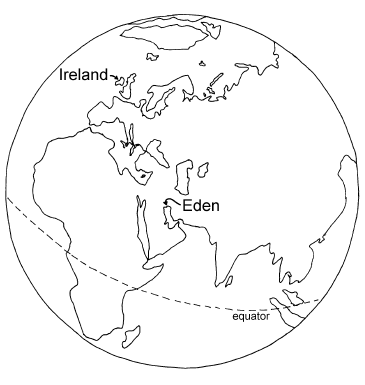 |
It is hardly mandatory, theoretically speaking, that the secular archaeological record of Ireland do so. One can imagine a variety of hypothetically possible prehistories for ancient Ireland before the Flood. One can imagine, for example, the possibility that Ireland was more or less heavily populated for many thousands of years prior to the Flood. Indeed, if one accepts the idea that humans have been around in essentially modern form for 25 to 35 thousand years, as paleoanthropology claims today, then it is not at all easy to understand why Ireland should not have been heavily populated for thousands of years before the Flood. Population growth is a geometric process, which means it tends to become very large rather quickly. Notice that we have come to a population of some five billion people on Earth today, starting from a very few individuals after the Flood 5,500 years ago. Notice also that within this relatively short 5,500 years since the Flood, Ireland has managed to become well populated, as it is seen to be today, and that it has, in fact, been well populated for several thousand years now. All of these secular observations press one toward the conclusion that Ireland should have been well populated long before the Flood. But quite contrary to this the Bible makes the claim that "men began to multiply on the face of the land" only in the interval between 5176±26 B.C. and 3520±21 B.C.—that is, only 7,000 years or less ago, not 20,000 or 30,000 years ago.
Now I must pause to clear up a potential misunderstanding before pressing on. I am not pitting the modern scientific claim that mankind appears to have been around in essentially modern form for 25 to 35 thousand years against the Biblical claim that mankind (and everything else) was only created roughly 7,000 years ago. If you are familiar with my work you know that I accept both of these claims as valid—that I find their reconciliation in the principle of virtual history. I find human remains which appear to be 25 to 35 thousand years old to be a legitimate part of the virtual history of the creation period (Creation, Fall, Curse), and in no way in contradiction to Biblical Creation roughly 7000 years ago.[2]
So I am not trying to pit the Bible against science. In fact, I believe rather strongly, as every issue of The Biblical Chronologist has demonstrated, that the Bible and science exhibit overwhelming harmony when both are treated in an intelligent, honest manner. I am trying only to point out that there is some secular theoretical basis for supposing that Ireland may have been more or less heavily populated for many thousands of years prior to the Flood.
Now if Ireland was more or less heavily populated for many thousands of years prior to the Flood, then the archaeology of ancient Ireland would reveal a much prolonged presence of mankind in Ireland. And this would not be very supportive of the Biblical claim that "men began to multiply on the face of the land" only in the interval between 5176±26 B.C. and 3520±21 B.C.
But—and this is the main thing I am driving at here—the archaeology of ancient Ireland reveals no such thing. Instead, it reveals a land, originally devoid of any significant human presence, suddenly, some centuries prior to the Flood, blossoming into a widespread human occupation. It supports the picture of an agriculturally competent human population overflowing into virgin frontiers and previously uninhabited lands. Indeed, it speaks of an unprecedented time between 5176±26 B.C. and 3520±21 B.C., "when men began to multiply on the face of the land".
How it does this is the focus of the present article.
How does one go about detecting human settlement of a virgin land over five and a half thousand years after the event?
One's first impulse is to look for the earliest datable human remains one can find in that land. But there are several difficulties with such an approach. For one thing, one never knows whether datable remains from the earliest settlement have been preserved down to the present time. And even when one has found very ancient archaeological remains one never knows whether yet earlier remains might be discovered if one just keeps looking.
Such difficulties are hardly fatal to the problem of determining the earliest settlement of a land archaeologically. Archaeology can, and routinely does make valid contributions to such questions. But there is a better way of getting at the answer to this particular question in this case. It is provided by the science of palynology.
Palynology is a branch of science dealing with pollen and spores. In the present case pollen is especially interesting because it reveals the types of plants which were covering the countryside at different times—each type of plant produces its own unique pollen.
The first settlers of Ireland, like the early European settlers of the east coast of North America, found a forested land when they first arrived there. The preponderance of arboreal pollen within ancient peat recovered from a deep bog in northwestern Ireland shows this to be the case, as demonstrated below.
They set about to clear the forests to make fields where they could plant their crops and graze their livestock, just as the early European settlers of North America did. We know this because the types of pollen higher up in the same deep bog are chiefly what one gets from fields—pollen of cereals and other grasses, and of characteristic field weeds such as ribwort, dock, buttercup, and dandelion. The forest had been driven back. Fields had been cleared and planted.
Thus a record of the ancient, human-mediated battle between forest and field in Ireland has been carefully archived for us for multiple millennia within the soggy peat of a deep bog, through the humble agent of microscopic pollen spores. By exploiting this ancient archive we can "see" when the first settlers arrived in Ireland by the tell-tale, sudden decline in arboreal (i.e., tree) pollen and synchronous rise in herbaceous (i.e., field plant) pollen.
It is not an easy task to exploit such a natural ancient archive. In the present case it involved: 1. locating the deep bog, 2. making numerous trial corings at the site to determine where the deepest, most ancient part of the record might be found, 3. obtaining a ten centimeter diameter core some five and a half meters (roughly seventeen feet) long from top to bottom of the bog, 4. sectioning the core back at the lab to obtain more or less evenly spaced, one centimeter thick samples for analysis, 5. submitting each of these one centimeter samples to an elaborate process to separate the pollen it contained from everything else one might find in a peat bog, 6. mounting each resultant pollen sample on a microscope slide, 7. identifying the individual type of up to 1000 pollen spores from each sample by viewing at 500× through the microscope, and, finally, 8. graphing the frequency of the different types of pollen versus the depth from which the sample was obtained in the peat core.
Fortunately, we did not have to do all this work. It had already been done for us (and the rest of the world), earlier this decade, by two scientists, Karen Molloy and Michael O'Connell, of the Palaeoenvironmental Research Unit, Department of Botany, University College Galway, Ireland.[3] It is our privilege in the present study merely to take note of the final results of their obviously protracted and meticulous labors.
Figure 2 shows the primary result of interest to the present investigation. It is a graph of composite pollen divided by percentage between forest types of pollen and field types of pollen. The "forest" types of pollen are mainly pine and other trees, with a generally minor contribution of tall shrubs and ferns. The "field" types of pollen are from the herb family, including cereals and other grasses as well as typical weeds, as mentioned above. To understand the graph, look, for example, at 510 centimeters depth using the scale at the left of the graph. The curve dividing forest and field pollen is at 99% (bottom scale) at this depth. This means that of the total forest and field pollen at that depth, 99% is forest pollen and only 1% is field pollen. This implies that the vicinity of the bog was mainly forest with essentially no open field at that time. Higher up in the peat core, at 478 centimeters below the modern surface of the bog (where the curve is furthest to the left), only 33% is forest pollen (bottom scale) while field pollen has increased to 67% (the remainder when you subtract 33% from 100%). This implies that much of the former forest has been replaced by open fields by the time corresponding to that depth. The more toward the right the curve is at any given depth, the greater the forest contribution and the less the field contribution at that time.
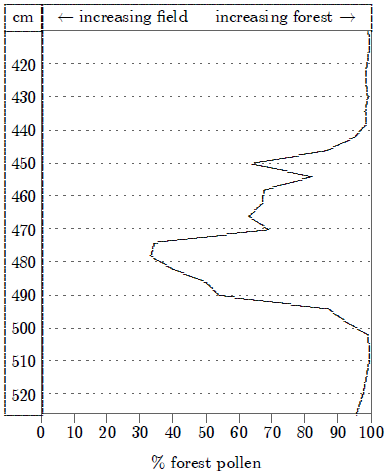 |
Figure 2 shows us an interesting episode in the battle between forest and field in the vicinity of this deep bog in Ireland. We can see immediately that at some depths within the core the forest was winning, while at other depths the fields were winning.
But this data is not very useful in this form. We are not really interested in the depth at which the fields or the forests were winning. We are interested in the time (the date) at which the fields or the forests were winning. We would like to know when, in time, these things were happening, so we can orient them relative to the rest of history—most importantly, relative to the Flood, 3520±21 B.C. For our purpose we need to be able to tell when each part of the peat core from the bog grew. When, for example, was the peat growing at the surface of the bog (collecting the pollen which settled out of the air from surrounding vegetation) which is now buried beneath 478 centimeters of more recent peat growth?
Here again Molloy and O'Connell have already done the work necessary to transform depth in the core to an absolute date for the formation of each section of the core. I will not go into all of the details of their chronology. Let me simply point out that it is mainly based on direct radiocarbon measurements of peat samples from the core itself.[4] I estimate their conversion to be accurate to ±150 years (3σ) in absolute date back to the 5.00 meter depth ( ca. 3900 B.C.). Chronological uncertainty at greater depths is larger and difficult to quantify. This results from a lack of radiocarbon dates at greater depths, and a probable hiatus in the core due to an ancient fire on the bog surface, as evidenced by charcoal-rich peat between 5.11 and 5.30 meters in the core today.
Figure 3 shows the pollen data of Figure 2 plotted versus time, the conversion from depth to time being accomplished using the chronology for this core worked out by Molloy and O'Connell. The data points defining the curve prior to about 3900 B.C. may be misdated by half a millennium or more. Fortunately, this large chronological uncertainty in the oldest portion of the curve alters none of the present discussion or conclusions.
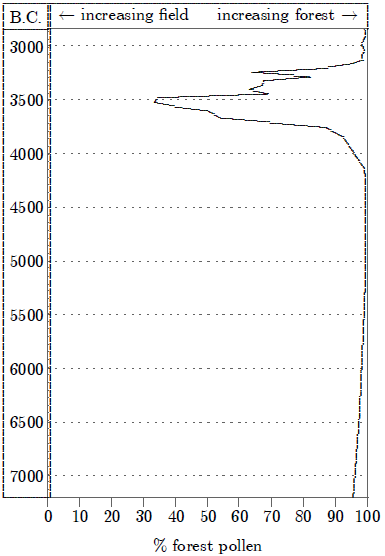 |
Figure 4 shows the Irish pollen data of Figure 3 together with key events from Biblical chronology for the same time interval. This time chart makes it possible to see immediately what these pollen data mean.
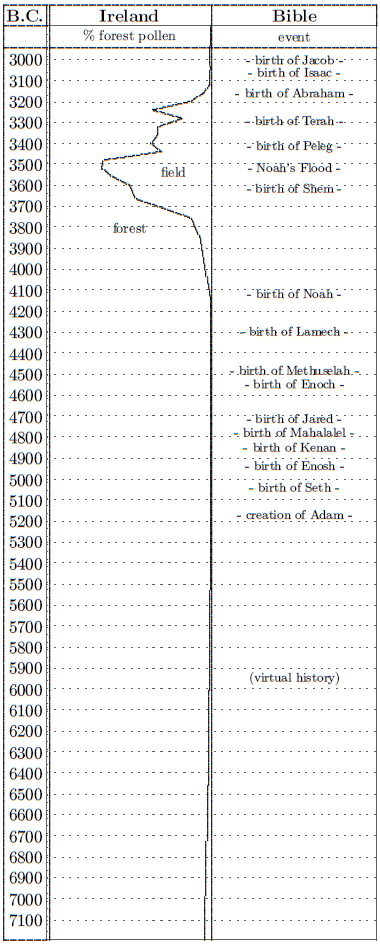 |
Notice first of all that Noah's Flood (3520±21 B.C.) is conspicuously synchronous with a sudden turn for the better for the forest (and turn for the worst for the fields) in the vicinity of this deep bog. This bog is located, in fact, within the pre-Flood, stone-walled field system at Céide Fields I discussed last issue.[5] The palynological evidence from this bog is consistent with the view that the pre-Flood occupants of Céide Fields were all swept away by the Flood, leaving no one to maintain the fields when the Flood was over. In the centuries following the Flood the fields naturally converted first to wild, overgrown meadows and, eventually, back to forest. Figure 4 shows that by four centuries following the Flood reversion of the region to forest was complete. Open field and meadow were by then all but extinct—the trees were in more or less complete possession of the land once again.
Now I must interject several side points here. First, last issue I pointed out that it is often difficult to get reliable radiocarbon dates on peat samples because peat is frequently subject to contamination. Notice that this does not seem to have been a problem in the present case. The Molloy and O'Connell chronology of the peat core—based on direct radiocarbon measurements on peat from the core—harmonizes immediately with the radiocarbon dates on the wood from the pine stumps we looked at last issue, and both are in immediate agreement with Biblical chronology.
Second, please notice that there is no way the remarkable agreement between the "Ireland" column and the "Bible" column of Figure 4 can be regarded as contrived. Molloy and O'Connell's detailed pollen analytical work at Céide Fields was completed in 1994. It was only in the summer of that year that I began to understand that the Flood should be properly dated to 3520±21 B.C. It is only in the last few months that I have become aware of Céide Fields and the pollen analytical work carried out there by Molloy and O'Connell. Thus, the chronologies of the two columns shown in the time chart of Figure 4 were necessarily derived entirely independently of one another. Not only are the researchers who were involved in the construction of these two chronologies entirely different and independent of one another, but also the data involved in the two cases is unique. The Molloy and O'Connell chronology of the peat core, used to construct the "Ireland" column, is based on radiocarbon measurements of peat samples. This is completely independent of the Biblical chronological data used to construct the "Bible" column. Yet these two independent chronologies harmonize immediately when placed side by side, both bearing witness to a Great Flood ca. 3520 B.C.
Third, notice that the harmony between these two chronologies logically supports both: 1. the general validity of modern, calibrated radiocarbon dates, upon which the "Ireland" column is based, and 2. the validity of the missing millennium thesis, upon which the "Bible" column is based.[6] I am tempted to belabor these two points because they are of such foundational importance to a correct view of history, and because a correct view of history is of such foundational importance to Christianity. But these things have already been sufficiently demonstrated and discussed in previous issues of this publication to need no further elaboration here.
Fourth and final, I need to point out that the peat core appears to be continuous right through the Flood. There is no evidence either of removal of peat during the Flood, or of deposition or sedimentation on top of the then living peat surface. The growth rate of the peat can be calculated from the thickness of peat between radiocarbon dates for the entire length of the core. When this is done one finds a result consistently on the order of one millimeter per year, except in the very deepest portion of the core where the evidence points to a hiatus in the core due to fire, as mentioned above. But the important thing to notice is that there is no hiatus of any sort near the Flood—the growth rate shows no anomaly near the Flood such as would result from any significant erosion or deposition at the living peat surface at the time of the Flood. This corroborates the hemispherical Flood model once again and is in harmony with all we have learned about the nature of the Flood to the present time.[7] The highly popularized idea within some sectors of Christianity today that the Flood waters eroded the surface of the earth deeply and deposited thick layers of sediment all over the globe is simply not borne out by chronologically controlled field data. Such a view of the Flood must be regarded as false, if evidence has anything to say about the matter. Based on available evidence it presently seems best to picture the waters of the Flood in this area of Ireland as encroaching upon the land like a rapidly rising tide at the beach—a tide which just kept rising and, ultimately, overflowed all boundaries.
Focusing attention on yet earlier times in Figure 4, it is possible to see the arrival of the first agricultural settlers at Céide Fields quite clearly. The forests, which had dominated the area for thousands of years previously, began to be beaten back beginning probably within 100 years of 4000 B.C. Arboreal pollen begins an exponential decline at about that time, while herbaceous pollen begins to soar. Herbaceous pollen continues to increase—the fields are being maintained and expanded—until the coming of the Flood, some 500 years later.
Thus pollen analytical studies reveal the earliest pre-Flood settlement of Ireland 4000±100 B.C. and the snuffing out of human occupation some 500 years later, by the Great Flood.
Five hundred years may seem a small thing relative to the many millennia of history back through which we peer to these pre-Flood centuries. But 500 years is a long time in terms of human occupation of a land. In distinctly American terms, 500 years takes us back to the time of the discovery of North America by Columbus. American society has come a long way since Columbus, and there is every reason to believe that Ireland, too, saw many changes and much development in those five centuries before the Flood.
Obviously, we must view the carefully planned miles of stone-walled fields at Céide Fields, and the impressive architecture of the associated megalithic tombs which modern archaeology has brought to light, not as rude beginnings of rustic settlers, but as by-products of a mature pre-Flood culture. And all of this we must view as but a small, and probably relatively late part of the unprecedented pre-Flood explosion of human population and concomitant geographical expansion of mankind out across the globe which Genesis 6:1 summarizes succinctly with the words: "when men began to multiply on the face of the land". ◇
It is time to update the "state of the subject" of Biblical Chronology once again. The last update appeared in the Volume 3, Number 6 issue of The Biblical Chronologist.[8] Since that issue went to press a great deal of progress has been made. Most importantly, my decades-long quest to harmonize Biblical and secular historical and scientific chronologies of earth history from the present back to the beginning of the creation has come to completion.
A time chart showing the current state of the subject and its progression throughout this decade is shown in Figure 5. As is usual for these state of the subject summary charts the "date" column on the left is purposely given in increments of 500 years; boundary lines between regions in the "state" columns are deliberately rounded to the nearest 500 years for the sake of simplicity; and regions are depicted as sharply bounded whereas there is some degree of gradation between them in actual practice.
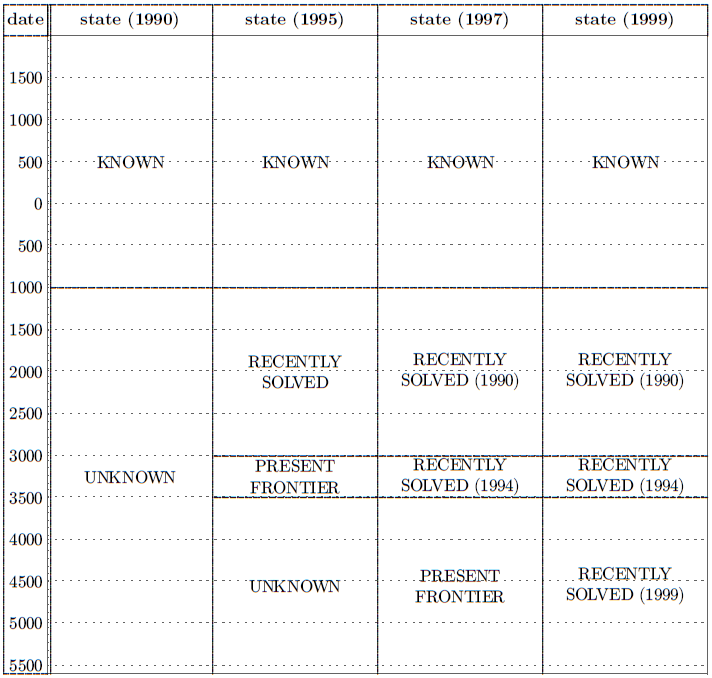 |
The "state (1990)" column shows the state of Biblical Chronology prior to the summer of 1990 and the discovery of the missing millennium in 1 Kings 6:1.[9] The time chart could be divided into two regions back at that time, 'KNOWN' and 'UNKNOWN'. The dividing line was roughly 1000 B.C., the time of Samuel, Saul, and David. After 1000 B.C. there was reasonable harmony between Biblical and secular accounts of history. Prior to that time, in the 'UNKNOWN' region, there was striking disharmony everywhere.
The discovery of the missing millennium in 1 Kings 6:1 altered all this. By the end of 1995 the state of the subject looked as shown in the "state (1995)" column.[10] By that time it was possible to declare the region from 1000 B.C. back to roughly 3000 B.C. solved. The most conspicuous Biblical historical events in this interval are the Exodus and Conquest. Scholars had bickered over the proper dates of these events for decades, and many modern scholars had come to the conclusion that these Biblical events were essentially mythological. The missing millennium thesis reset the paradigm completely, sweeping away decades of confusion, and bringing immediate harmony to Biblical and secular data.
Two years later it was possible to declare the region from 3000 to 3500 B.C. solved.[11] This region terminates with Noah's Flood at 3520±21 B.C. Noah's Flood is regarded as mythological by the vast majority of modern scholars. But here again the missing millennium thesis resets the paradigm and opens the door to the discovery of the Flood within the data of a variety of secular disciplines. As a result, understanding of the Flood has been revolutionized. Though the date, historical reality, and basic nature of the Flood are now clear enough there is still much to be learned in connection with this historical event.
Another two years later brings us to the present time. It is now possible to declare the remaining portion of Biblical chronology solved, from the Flood back to remotest times. This region takes us back to the dawn of Creation. It contains the long-debated "age of the cosmos" and "antiquity of man" problems, with their dependent "young-earth versus old-earth" and "creation versus evolution" debates. The key to the long-sought harmonization in this region is the "principle of virtual history".[12] This principle informs us that data from the physical realm seeming to predate Creation is to be expected.
The elucidation of the principle of virtual history is quite recent. Just as we had to learn (and are still learning) how to think about the Flood, so we will have to learn how to think about Creation and virtual history. It has not been a trivial exercise learning how to think accurately about the Flood. We can expect it to be a much more challenging exercise learning how to think accurately about the Creation period (i.e., Creation, Fall, and Curse). The Flood, for all its stupendous magnitude, we have learned, is still a natural phenomenon in terms of its basic processes. I do not mean to imply by this that God had nothing to do with the Flood. In point of fact, I believe that certain aspects of the Flood, such as its timing, God's advance warning to Noah, and the closing of the door of the ark, can only be properly understood as supernatural phenomena, just as the Bible portrays them. Rather, I mean to communicate that God appears to have used natural agents—a cosmic projectile, a resulting inner core displacement, and gravity, for example—in accomplishing the Flood.[13] In sharp contrast to this, the Creation is blatantly supernatural from beginning to end.
We are familiar with natural phenomena; we experience them in action every moment of every day. But the opposite is true with supernatural phenomena. In their case our ignorance and lack of practical experience is profound. If we have found the (fundamentally natural) Flood difficult to accurately conceptualize, we can expect an accurate understanding of the nature of the (blatantly supernatural) Creation period to be much more difficult. We should not be surprised to find the nature of virtual history in proleptic time to be in sharp contradiction to "common sense" (which is just our sum total appraisal based on the limited amount of practical experience we have gained with the world around us from the cradle to the present time) and in blatant opposition to all our cherished prejudices regarding the nature of the beginning of the world.
I do not mean to discourage anybody by this observation. On the contrary, I hope to arouse men, women, and young people of able mind to the task which lies ahead. Mysteries deeply embedded within the substance of God's great creation since the dawn of time are now waiting to be revealed. Let us press forward with anticipation.
When I first began to publish The Biblical Chronologist back in 1995, I pointed out, in this column, that there is an intimate relationship between Biblical Chronology and Christian apologetics.[14] I used the illustration reproduced below to picture this relationship. I explained this illustration as follows:[15]
I picture Biblical Chronology as a foundation block extending from the heights of Reason toward the heights of Faith. In itself it cannot span the chasm between, but upon it is laid another foundation block called Biblical Historicity. It also is too short to span the remaining gap, but upon it a final block called Apologetics is laid. This final block is able to bridge the remaining distance, thereby linking Faith and Reason and completing the foundation of Truth. If Biblical Chronology is removed or broken, the remainder is lost into the chasm called Nihilism.
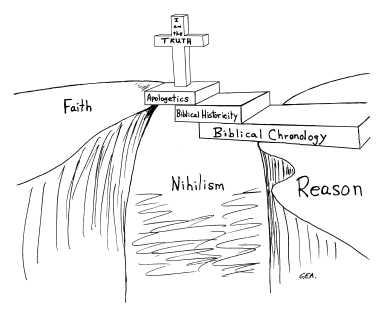 |
The "Biblical Chronology" foundation block appeared to have been broken and lost into the chasm over a century ago when men of science began to perceive that the history of the earth should be measured in billions rather than a few thousands of years. The result has been several generations of conservative Christians who have clung to the lip of Faith, and, simultaneously, several generations of liberal Christians who have clung to the lip of Reason, both together shuddering all the while at the chasm beneath their feet. (Not that all Christians in either group are aware of the chasm, by any means. Some have managed to convince themselves, by sheer force of rhetoric, that they stand on solid ground. Others are in more subtle forms of denial. Many seem to have come to accept hanging by their fingernails over a precipice as normal—the idea that the cross should stand upon a solid platform equally satisfying to both faith and reason has become foreign to them.)
For the past four and a half years the goal of The Biblical Chronologist has been to restore the "Biblical Chronology" block. This goal has now been reached. We are now able to give a defensible chronology of Bible history from beginning to end. We are able to answer quantitatively when the Exodus happened, when the Flood happened, and when Creation happened. And we are able to show that secular data harmonize with the Biblical history of these events at these dates. We have achieved a unified chronology of earth history—one which works both Biblically and scientifically.
The fact that this goal has been reached means that a new era has begun. Now I personally believe that we are entering a new era for Christianity as a whole—that God is up to something quite unusual at the present time. But I do not yet perceive clearly what this is, and I have no desire to speculate on so grand a scale. I wish merely to point out that we have entered a new era for the discipline of Biblical Chronology, and The Biblical Chronologist is bound to reflect this change. With the quest to find a defensible unification of sacred and secular chronologies of earth history behind us, what remains to be done?
The discipline of Biblical Chronology will always have a job to do, until the Lord returns. Its job is to maintain, refine, and continue to build a Bible-centered, unified chronology of earth history. We now have a workable unification of secular and sacred chronologies of the world, but it is a skeleton only at present. We are now in a position—for the first time ever—to begin to understand the true relationship between any and all data from the historical sciences and the historical narrative of the Bible—to put some muscle on the skeleton. We must be about this task.
The lead article this issue is a good example of what I mean here. It has addressed itself to the problem of correlating a peat core chronology from Ireland with Biblical chronology. The purpose in this has not been to try to figure out how to harmonize Biblical and secular chronologies. That job is done. Rather, the purpose has been to use the unified chronology which has already been derived to increase our understanding of these ancient times, that we might be found "rightly dividing the word of truth" (2 Timothy 2:15) in our generation.
All chronologies of the past, from all around the globe must ultimately be integrated with Biblical chronology in just this sort of way—a very big job. The purpose in this is to strengthen the "Biblical Chronology" block, thus further undergirding Biblical historicity and ultimately Christian apologetics. The perverse spectacle of God's Word (the Bible) and God's world (science) supposedly in opposition to one another, must not be allowed to be seen again. And in this matter it is the humble discipline of Biblical Chronology which is the divinely appointed guardian.
As the unified chronology is refined and built, discoveries of one sort or another will inevitably result. The discovery that Mt. Cilo is the most likely mountain in the Ararat region for the ark to have landed on is an example of what I am thinking of here.[16] There is a responsibility to follow up on such discoveries, of course, to see where they ultimately lead. The search for the ark on Mt. Cilo is an obvious example in this category.[17] Further work on the cause of the Flood, and the cause of reduced human longevity following the Flood—a new topic I hope to tackle soon—are other examples in this category. Obviously, there is not likely to be a lack of things to do for quite some time yet. But in all of this we must not loose sight of the fact that a new era has begun. We now have a complete unified chronology to work from—we no longer labor in ignorance; we no longer battle from the defensive.
In closing this summary it seems appropriate to draw attention to Figure 6. It attempts to show the state of Biblical Chronology to the present time in panoramic view.
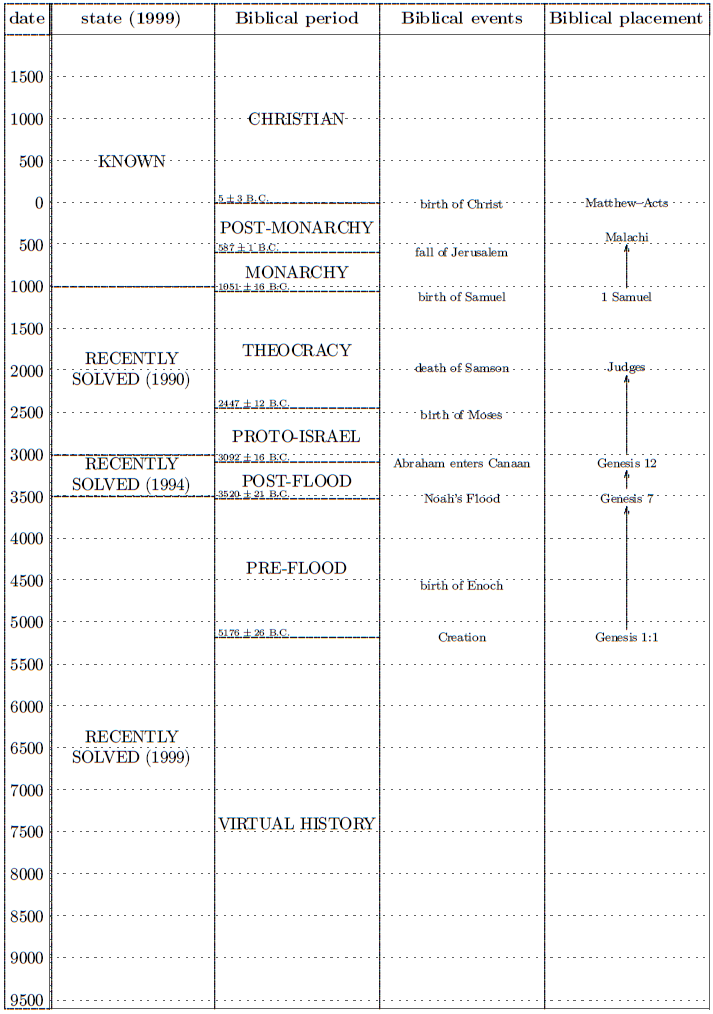 |
This time chart is fairly self-explanatory so I will not discuss it at any length here. But I would like to point out that the ability to display such a chart, giving a complete, defensible chronology of earth history universally applicable to all disciplines, sacred and secular, marks a tremendous stride forward for Biblical Christianity.
In practical terms it means many things. Let me mention just one. It means that the Bible can no longer be relegated to just the realm of "religious literature" in institutions of higher learning around the globe. In addition to "religious literature" the Bible must now be seen, at the very least, to be an accurate source of ancient chronological and historical data, completely unparalleled by any other piece of "religious literature"—indeed, completely unparalleled by any piece of literature of any sort whatsoever.
Here is a remarkable Book by any standard, professing all the while to be the very Words of God. Perhaps the time has come for men and women of learning to begin to take its claims seriously once again. Let us do what we can to show them so. ◇
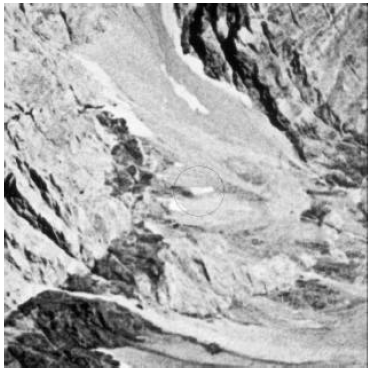 |
The immediate goal continues to be to determine if IO3 (Interesting Object #3) shown in Figure 7, taken from a satellite over thirty years ago, is still there on the slopes of Mt. Cilo at present. The research team had hoped to gain this and other important information by ordering custom, high-resolution, commercial satellite photographs of the south side of Mt. Cilo late this summer when snow cover should be least. Unfortunately, the launch date for the commercial satellite seems to have been delayed, so it may not be possible to procure these high-resolution photos this year.
If procurement of a custom commercial satellite photo is not possible this summer the research team will probably turn to (lower resolution) commercially available archived satellite photos in hopes of learning more from them. Some of the archived material is quite recent and might serve to answer our primary question at this stage of whether IO3 is still there. This will depend on snow cover, cloud cover, and other factors at the time the photo was taken. The minimum cost for suitable archived material is expected to be $2500. The archived material has a resolution similar to the thirty year-old satellite photos shown in this column last issue, so they will not provide a more detailed view of IO3. They are likely to show IO3 at other camera angles, however, which could provide additional insights into its nature.
Other routes of obtaining additional information on IO3 are also being explored. It presently appears that future air or ground based expeditions into IO3 are likely to be hampered by the unstable political situation in the vicinity of Mt. Cilo. ◇
The Biblical Chronologist is a bimonthly subscription newsletter about Biblical chronology. It is written and edited by Gerald E. Aardsma, a Ph.D. scientist (nuclear physics) with special background in radioisotopic dating methods such as radiocarbon. The Biblical Chronologist has a threefold purpose: to encourage, enrich, and strengthen the faith of conservative Christians through instruction in Biblical chronology, to foster informed, up-to-date, scholarly research in this vital field within the conservative Christian community, and to communicate current developments and discoveries in Biblical chronology in an easily understood manner. An introductory packet containing three sample issues and a subscription order form is available for $9.95 US regardless of destination address. Send check or money order in US funds and request the "Intro Pack." The Biblical Chronologist (ISSN 1081-762X) is published six times a year by Aardsma Research & Publishing, 412 N Mulberry, Loda, IL 60948-9651. Copyright © 1999 by Aardsma Research & Publishing. Photocopying or reproduction strictly prohibited without written permission from the publisher.
|
^ Gerald E. Aardsma, "Noah's Flood: The Irish Evidence," The Biblical Chronologist 5.3 (May/June 1999): 1–7.
^ Gerald E. Aardsma, "A Unification of Pre-Flood Chronology," The Biblical Chronologist 5.2 (March/April 1999): 1–18.
^ Karen Molloy and Michael O'Connell, "Palaeoecological investigations towards the reconstruction of environment and land-use changes during prehistory at Céide Fields, western Ireland," Probleme der Küstenforschung im südlichen Nordseegebiet 23 (1995): 187–225. [My thanks to R.E. Wehrwein for special assistance in procuring a copy of this article.]
^ The Molloy and O'Connell chronology of the section of core of interest to the present study is a piecewise linear interpolation between the points: (396 cm, 4647 cal BP), (488 cm, 5565 cal BP), (500 cm, 5835 cal BP), and (534 cm, 10,163 cal BP). The first three points incorporate seven radiocarbon dates on peat from the core. The final (oldest) point relies on pollen evidence alone.
^ Gerald E. Aardsma, "Noah's Flood: The Irish Evidence," The Biblical Chronologist 5.3 (May/June 1999): 1–7.
^ Gerald E. Aardsma, A New Approach to the Chronology of Biblical History from Abraham to Samuel, 2nd ed. (Loda IL: Aardsma Research and Publishing, 1993).
^ Gerald E. Aardsma, "The Cause of Noah's Flood," The Biblical Chronologist 3.5 (September/October 1997): 1–14.
^ Gerald E. Aardsma, "Biblical Chronology 101," The Biblical Chronologist 3.6 (November/December 1997): 11–14.
^ Gerald E. Aardsma, A New Approach to the Chronology of Biblical History from Abraham to Samuel, 2nd ed. (Loda IL: Aardsma Research and Publishing, 1993).
^ Gerald E. Aardsma, "Biblical Chronology 101," The Biblical Chronologist 1.6 (November/December 1995): 8–10.
^ Gerald E. Aardsma, "Biblical Chronology 101," The Biblical Chronologist 3.6 (November/December 1997): 11–14.
^ Gerald E. Aardsma, "A Unification of Pre-Flood Chronology," The Biblical Chronologist 5.2 (March/April 1999): 1–18.
^ Gerald E. Aardsma, "The Cause of Noah's Flood," The Biblical Chronologist 3.5 (September/October 1997): 1–14.
^ Gerald E. Aardsma, "Biblical Chronology 101," The Biblical Chronologist 1.2 (March/April 1995): 4–6.
^ Gerald E. Aardsma, "Biblical Chronology 101," The Biblical Chronologist 1.3 (May/June 1995): 4–5.
^ Gerald E. Aardsma, "The Ark on Ararat?," The Biblical Chronologist 3.2 (March/April 1997): 1–12.
^ Gerald E. Aardsma, "Research in Progress," The Biblical Chronologist 5.3 (May/June 1999): 7–16.